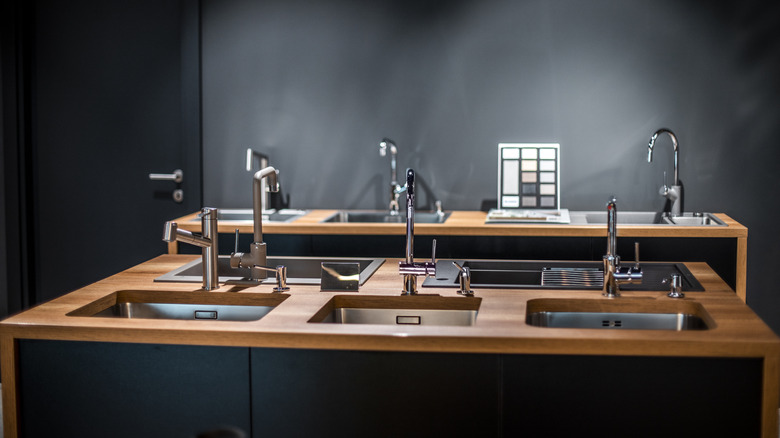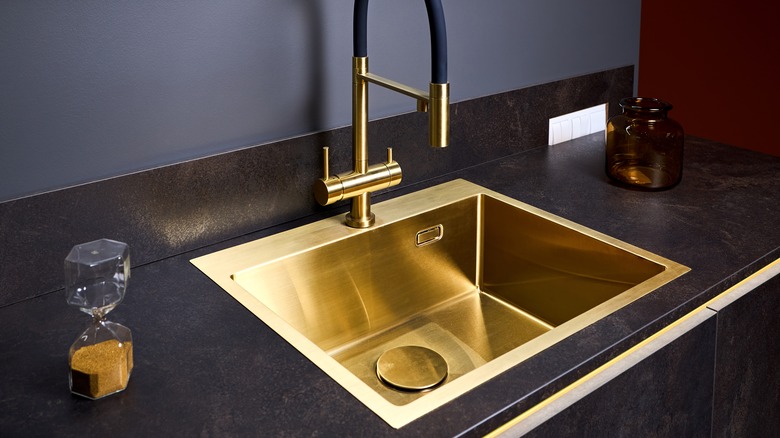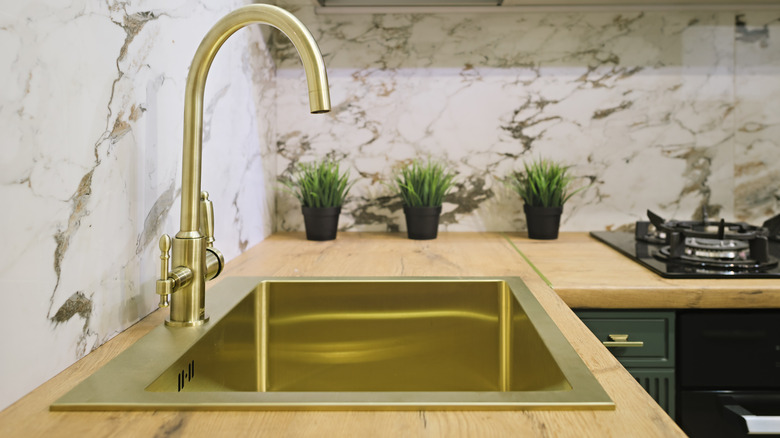The Luxe-Looking Kitchen Sink Material You're Better Off Avoiding
What if we told you that, for a high price, you could have a kitchen sink that's guaranteed to change color over time and that's so prone to damage that many manufacturers essentially pre-damage them by adding a hammered finish? This is basically the deal you get with an unlacquered brass sink. If you add lacquer to protect the finish, you get the additional benefit of not being able to use hot water in your sink. It's gorgeous stuff, but if you're not ready to wince every time someone drops a fork or drains pasta in your sink, something that's less of a labor commitment might be in order.
It could be worse. Sink manufacturer Elkay recommends that you dry copper sinks after each use. You read that right. Of course, we've also seen people recommending that you not submerge brass (an alloy of copper and zinc) in water at all. This kind of guidance is fundamentally about tarnishing, the oxidizing process that darkens brass, and if you don't mind the tarnished look, it might be less of a concern for you. Problems persist, though, since the tarnish is easily removed by ketchup, lemon juice, vinegar, and other acids ... leaving you with an uneven tarnished finish. You can also clean brass with WD-40, though this might not be a particularly appealing way to deal with a kitchen sink.
Is a brass-plated sink a better idea?
For durability's sake, you might think that a sink that is merely electroplated with brass over a steel or cast-iron body makes some sense. And, in terms of the natural softness of brass, it would certainly help. But there are problems inherent in this approach, too. A brass-plated sink is typically a very thin plating of brass applied to a stronger metal and then coated with lacquer. This thin layer of brass is prone to deterioration with use, and while a steel or iron sink can be re-plated, this probably isn't something you want showing up regularly on your to-do list, as it involves uninstalling the sink and taking it to an electroplating specialist.
The lacquer layer's job is to protect the thin layer of brass, but that comes with problems of its own. Suffice it to say that lacquer can be removed with hot water, so lacquering seems a little like painting a motorcycle helmet on your head. So, whatever you've gained in structural strength from the underlying steel or cast iron, you've undermined by introducing an easily eroded electroplating and an easily removed protective lacquer.
Is lacquered solid brass the answer?
Since thin brass plating is fragile, why not apply the protective lacquer to a solid brass sink? This is actually a better solution, but for a relatively unpleasant reason: You can use stronger chemicals to more quickly remove lacquer from solid brass sinks. And, in fact, it's something you might need to do periodically so that you can polish the brass beneath and then re-lacquer the sink. (You can polish brass with a DIY mixture of salt, white vinegar, and AP flour, but you absolutely must not polish it until the lacquer is removed.)
Brassworks Co. of Baltimore, MD, says that its lacquering process can last up to 20 years, then offers this caveat: "Lacquer on objects exposed to moisture ... will not hold up as long." So lacquering isn't doing much to lessen the labor required in owning a brass sink. And, ultimately, it might be a good idea to either foster an appreciation for tarnished brass or avoid using nontraditional sink materials to make a statement, since they tend to come with various issues.


